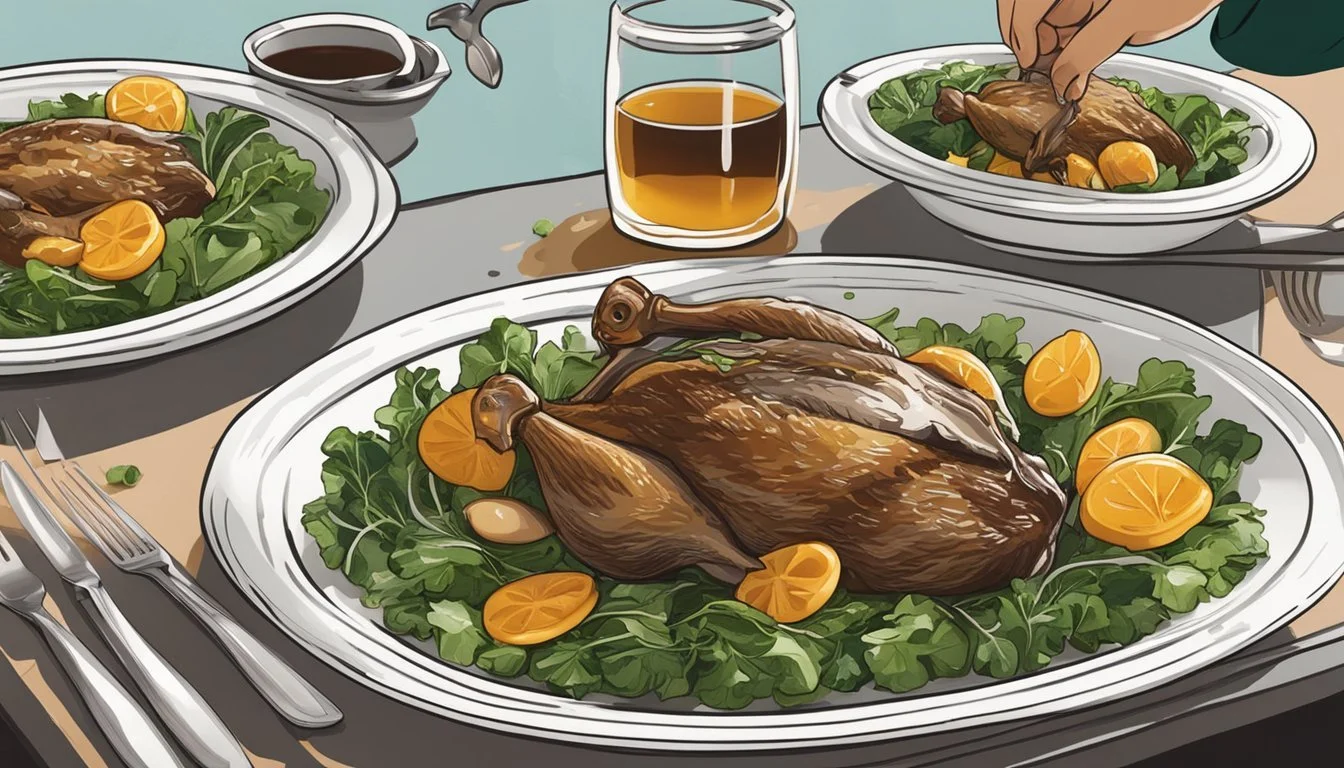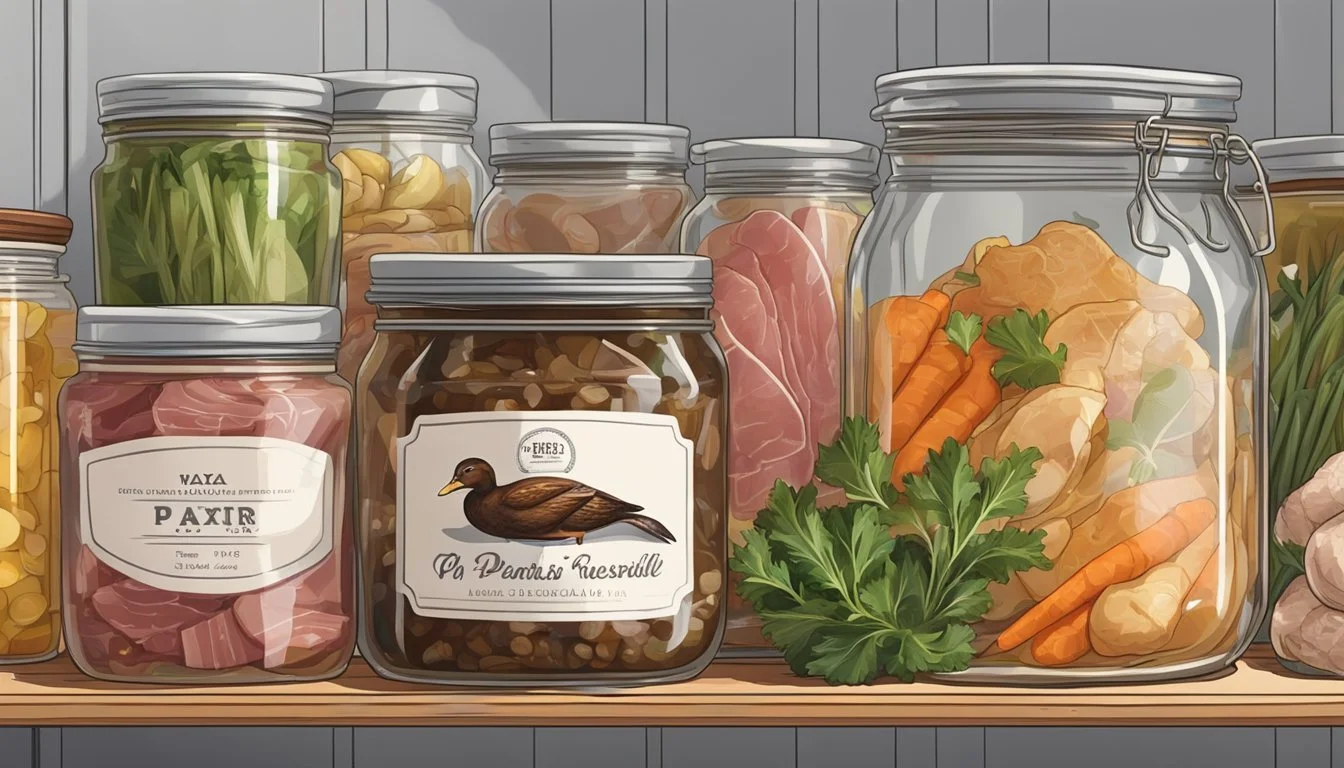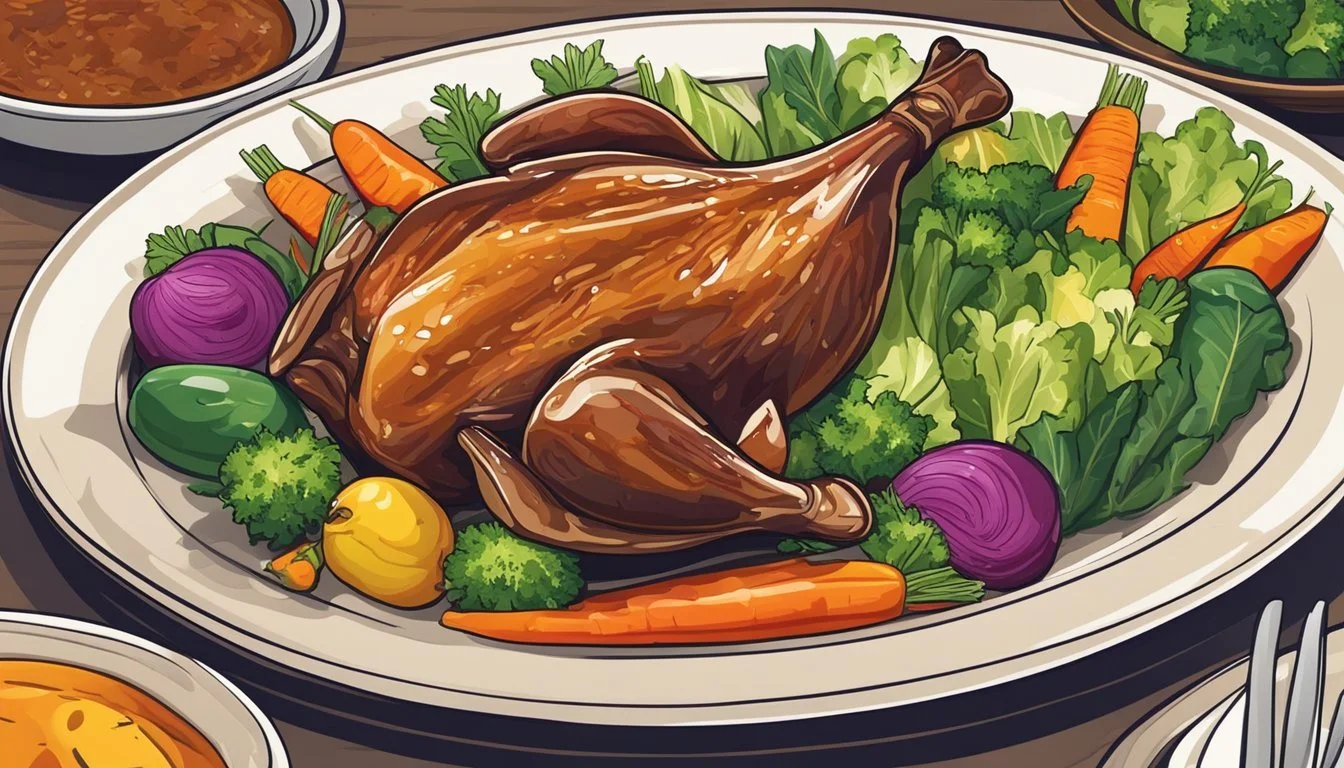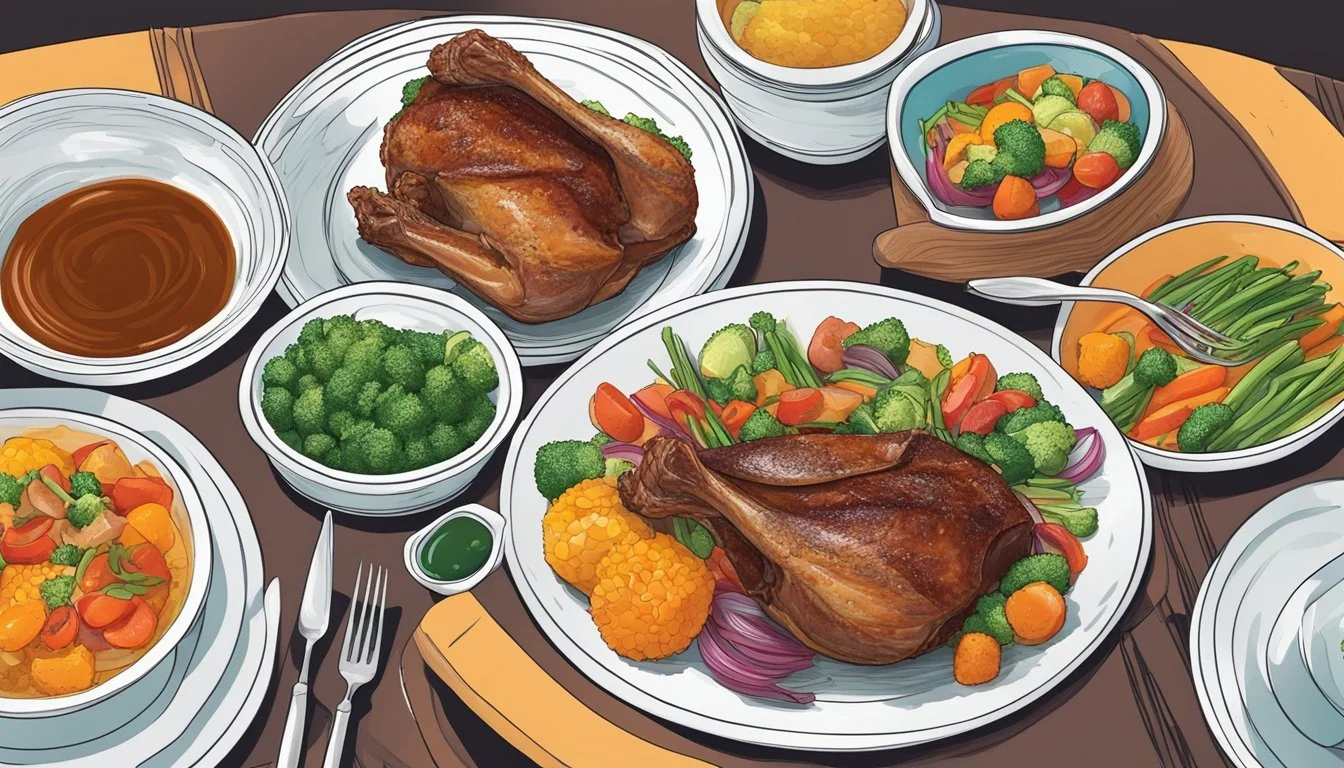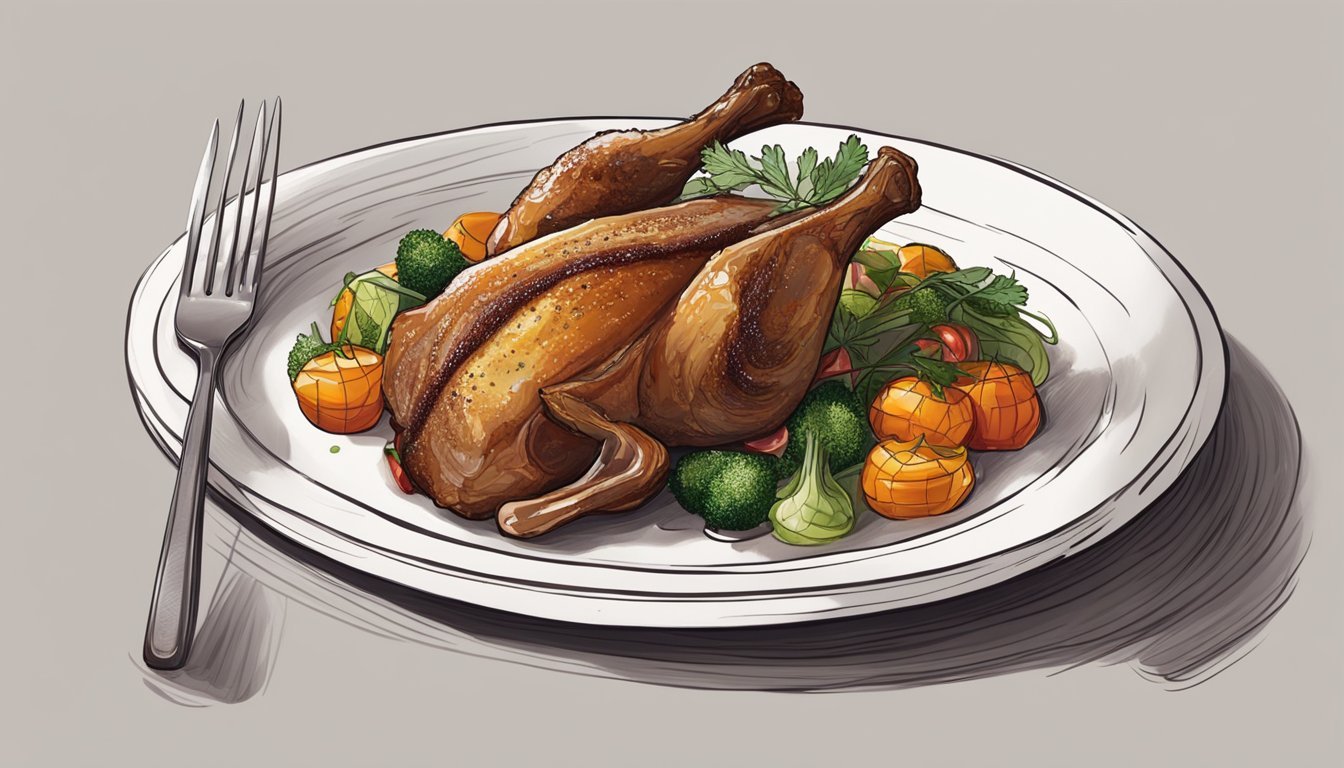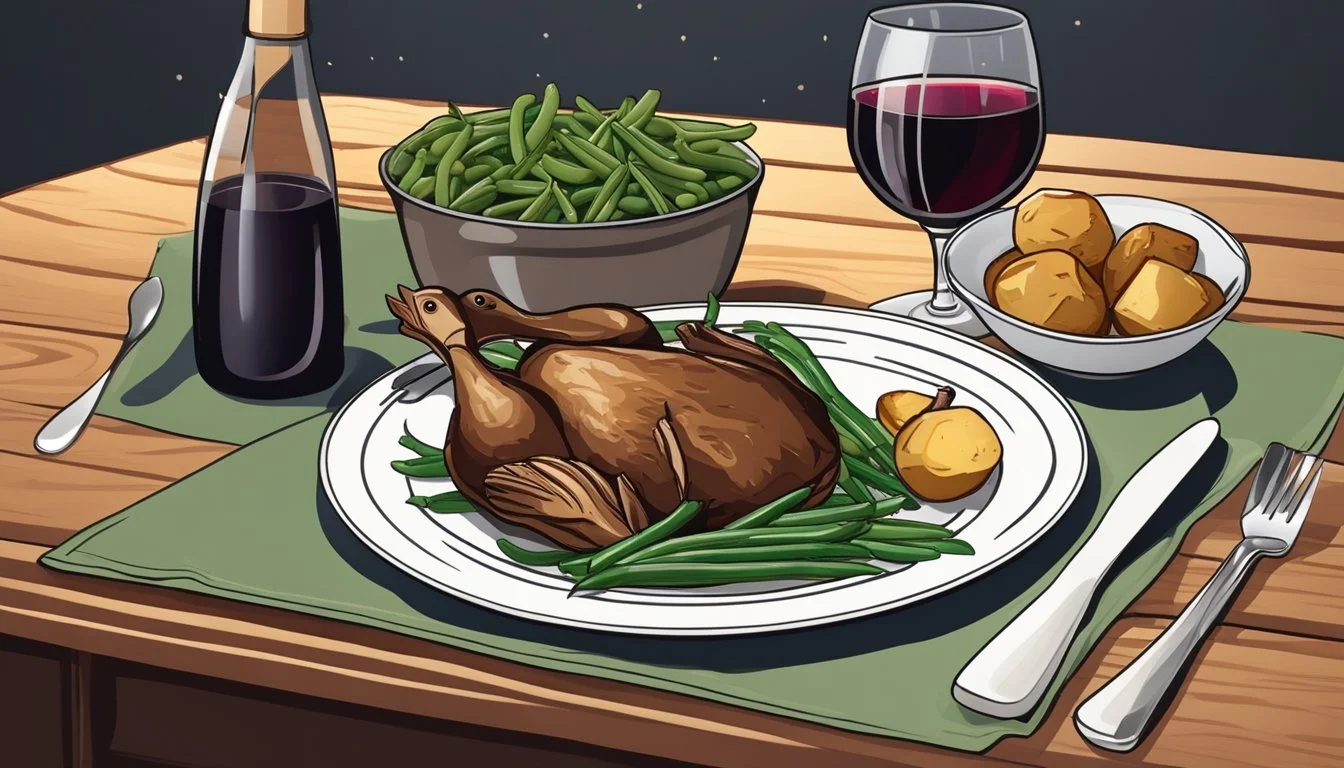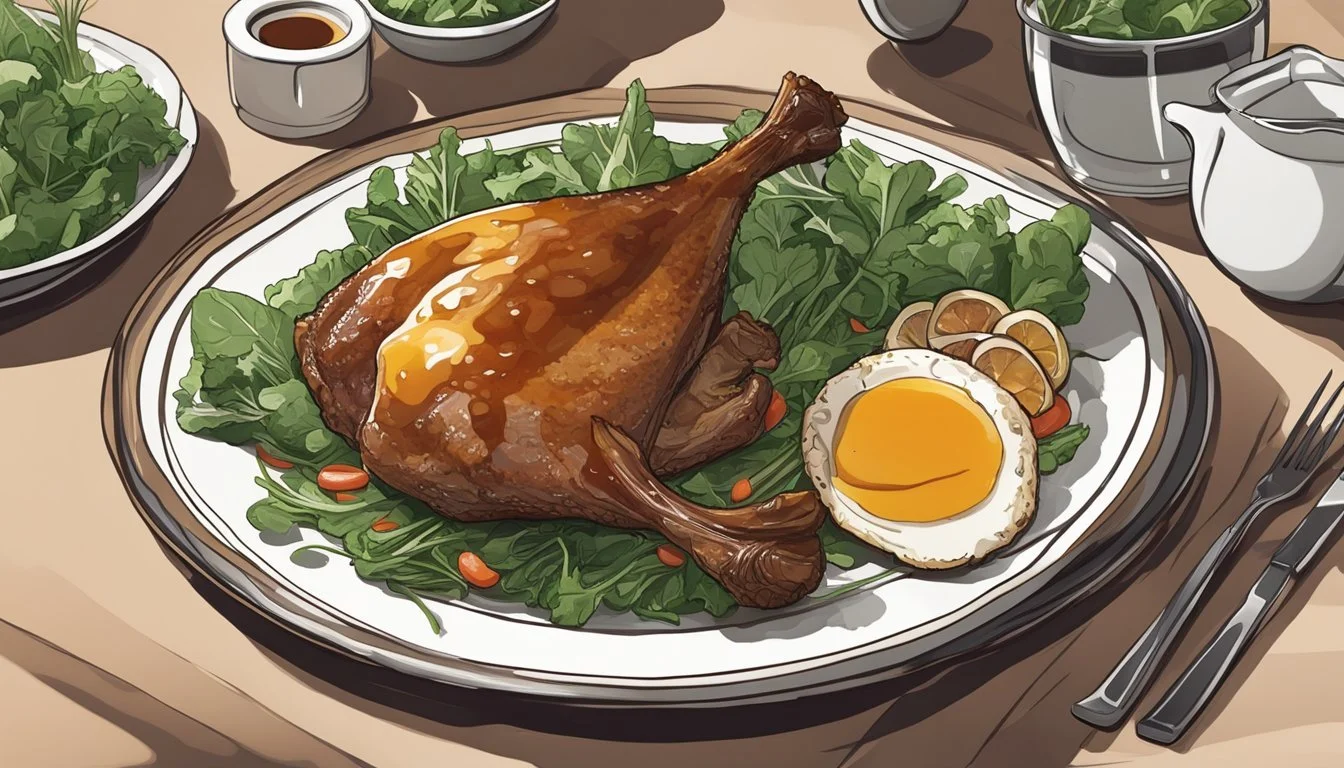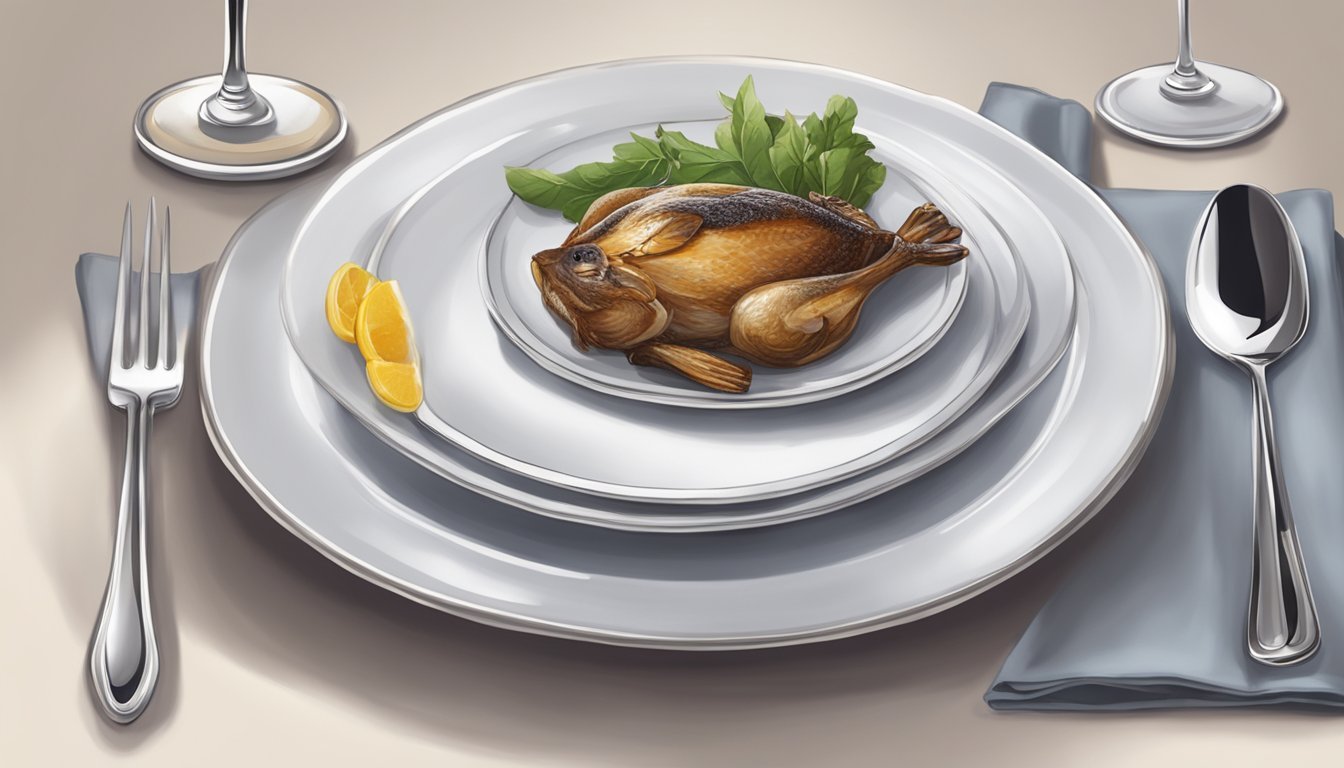How do You Eat a Duck Confit?
Mastering the Art of Savoring This Classic Dish
Duck confit (What wine goes well with duck confit?) is a staple in French cuisine, renowned for its rich flavor and tender texture. This classic French dish involves cooking the duck slowly in its own fat, a method that preserves the meat and imparts a depth of flavor that's hard to replicate with any other technique. Eaten across France and appreciated by gourmands worldwide, duck confit is often regarded as a luxurious comfort food, combining the heartiness of slow-cooked meat with the sophistication of French culinary tradition.
Traditionally, duck confit is served with sides that complement its richness and balance the palate. Simple side dishes, such as lentil ragout, cassoulet, or sauteed greens, are favored for their ability to enhance the duck's flavor without overpowering it. To cut through the decadence of the meat, a fresh salad like arugula or winter citrus can add a refreshing note.
Despite its elaborate preparation, duck confit can be enjoyed in a variety of settings, from an elegant dinner party to a modest family meal. Whether it's featured in a pie, laid atop a salad, or even incorporated into brunch fare, duck confit remains a quintessential representation of the finesse inherent in French cuisine. The versatility of this dish allows it to be savored in numerous ways, each method showcasing the duck's succulent character and the timeless culinary artistry of France.
The Basics of Duck Confit
Before delving into the sumptuous world of duck confit, it’s essential to understand its rich heritage, the culinary technique that defines it, and its revered status in French cuisine.
What Is Duck Confit?
Duck confit, known as "confit de canard" in French, is a time-honored food preparation where duck legs are slowly cooked in their own fat. This method not only tenderizes the meat but also preserves it, allowing for a unique combination of textures and flavors. One finds the meat to be melt-in-your-mouth tender, juxtaposed with the crispiness of the skin after final searing or roasting.
History and Origin
The technique of confit emerged out of necessity in Gascony, a region in southwest France renowned for its duck dishes. Preserving meats in fat was a pragmatic solution before the advent of refrigeration. Duck confit in particular has a storied past, dating back to ancient times and deeply entwined with Gascony's culinary landscape. It has been passed down through generations not simply as a recipe but as a cultural heritage.
Importance in French Cuisine
In French cuisine, duck confit holds a place of high esteem and can be found at the heart of classic French bistro menus. For many, it represents the pinnacle of rural French cooking traditions, a testament to the ingenuity and flair of turning simple ingredients into extraordinary food. Duck confit exemplifies French cuisine's emphasis on both flavor and technique, showcasing how regional dishes have evolved into celebrated classics.
Preparation Techniques
Duck confit relies on time-honored preparation techniques to achieve its rich flavor and tender texture. The process requires precise ingredients and methods, from selecting the right type and amount of salt to employing a slow-cooking method that ensures the meat is both preserved and succulent.
Ingredients and Substitutions
Duck confit primarily uses duck legs, which are known for their rich flavor and succulent meat. The legs are seasoned with kosher salt for curing, as it's pure and free from additives. Thyme, garlic, and bay leaves are often added for their aromatic properties. Black peppercorns and juniper berries can also be used to infuse depth in the seasoning. In a pinch, sea salt can substitute for kosher salt, and dried herbs may stand in for fresh when not available. Melted duck fat is essential, as it acts as a preservative and cooking medium, imbuing the duck with a distinctive taste.
Main Ingredient Substitutions Duck Legs (No common substitute) Kosher Salt Sea Salt Fresh Thyme Dried Thyme Fresh Garlic Granulated Garlic Fresh Bay Leaves Dried Bay Leaves Black Peppercorns Ground Black Pepper Juniper Berries (Optional) Melted Duck Fat (No common substitute)
Salting Process
The salting process, or salting, is critical for flavoring the meat and also acts as a preservative. Generously cover the duck legs with kosher salt and a mix of spices like thyme, crushed garlic, bay leaves, peppercorns, and optional juniper berries. The amount of salt used is crucial; enough to coat the meat thoroughly, but not so much as to overpower it. Letting the meat cure for 24-48 hours allows for the salt and herbs to penetrate deeply.
Slow-Cooking Method
Slow-cooking is the heart of confit preparation. After curing, rinse the duck legs to remove excess salt and pat them dry. Lay the legs in a single layer in a cooking vessel and submerge them completely in melted duck fat. Cook at a low temperature — typically 225°F (105°C) — for several hours until the meat is tender and can be easily pierced with a fork. The fat acts as a barrier to bacteria and enables the duck legs to be preserved for an extended period when kept submerged in the fat. As a result, the duck emerges from the slow-cooking process with a melt-in-the-mouth texture, imbued with the flavors of the salt, spices, and fresh herbs used during salting.
Cooking and Serving
Duck confit is a traditional French dish that requires a careful approach to heating and presenting to preserve its delicate texture and rich flavor. A methodical warming and careful combination with complementary sides and presentation can elevate the dining experience.
Warming and Serving Suggestions
To properly warm duck confit, one should place it skin-side down in a pan and heat it at a medium-high temperature. The aim is to ensure that the duck fat becomes bubbly and the skin turns crispy without burning the meat. For oven warming, a low oven setting of 225°F (105°C) can gently heat the duck through while crisping up the skin. As a main course, the confit duck can be broiled briefly to achieve a satisfying texture—crisp on the outside and tender on the inside.
Accompaniments and Side Dishes
Duck confit pairs well with a variety of sides.
Salad: A simple green salad with a tart vinaigrette balances the richness of the duck.
Potatoes: Roasted potatoes make for a heartier option, especially when cooked in duck fat.
Pasta: For a more luxurious dish, one can toss pasta with pieces of duck confit and garlic.
One can consider these options for a well-rounded meal:
Side Dish Preparation Pairing Note Green Salad Light vinaigrette dressing Adds a touch of acidity Roasted Potatoes Cooked in duck fat Complements the duck's flavor Pasta Tossed with garlic and duck pieces Offers a rich and robust taste
Presentation Tips
The presentation of duck confit can be as important as the cooking process.
Plating: Serve the duck legs whole on the plate for visual impact.
Crispy Skin: Ensure the skin is presented upwards and is visibly crisp.
Garnishing: A sprinkle of fresh herbs can add color and freshness.
When plating, one might consider the arrangement of accompaniments around the confit to provide color contrast and make the dish visually appealing. The duck should be the star of the show, with sides and garnishes playing supporting roles.
Storage and Preservation
Duck confit's longevity and flavor depend significantly on proper storage and preservation methods. These techniques are crucial in maintaining the quality of the confit and ensuring its safe consumption.
Refrigerating and Freezing
After cooling to room temperature, duck confit should be placed in the refrigerator. The meat is best preserved when submerged in its cooking fat in a sealed container. This creates an anaerobic environment that deters bacterial growth. For freezing, one should transfer the duck confit into freezer-safe containers or bags, ensuring they are sealed tightly to prevent freezer burn.
Fridge: Store in a sealed container, with meat submerged in fat.
Freezer: Use freezer-safe containers, removing as much air as possible.
Shelf Life
The shelf life of duck confit varies depending on the storage condition. When refrigerated properly and kept completely covered in fat, the confit can last for several months. However, once frozen, duck confit can maintain its quality for up to six months.
Refrigerator: Several months, if submerged in fat.
Freezer: Up to six months, when stored correctly.
Reheating Tips
To reheat duck confit, one must slowly warm the confit in an oven or on a stovetop to preserve its tenderness and flavor. The process should be gentle to prevent the meat from drying out or burning.
Preheat oven to a low temperature (around 325°F or 165°C).
Place the duck in an oven-safe dish and heat until warmed through.
Nutrition and Diet
Duck confit is a rich and flavorful dish, but it is also high in calories and fat due to the cooking process, which involves slow-cooking duck parts in their own rendered fat. It is important to consider these nutritional aspects when incorporating duck confit into one's diet.
Caloric Information
Duck confit is calorically dense, primarily because it is cooked and preserved in duck fat. A typical serving can contain:
Calories: Approximately 300-400 calories per 100 grams
Fat: Upwards of 30 grams, with a significant portion being saturated fat
Please note that serving sizes and preparation methods can result in variations to these figures.
Health Considerations
When enjoying duck confit, one should consider its place within a balanced diet:
Duck confit should be consumed in moderation due to its high fat content, particularly saturated fat which can impact heart health when eaten in excess.
The flavor of the dish is inherently tied to the rendered fat it's cooked in, which carries both the culinary character and the nutritional weight.
Incorporating vegetables and choosing sides that are lower in calories and fat can help balance the meal.
As with any indulgent dish, balance and moderation are key in maintaining a healthy diet.
Culinary Variations
Duck confit is a versatile dish with a variety of culinary interpretations that range from traditional regional recipes to innovative modern-day applications. These variations showcase the adaptability of duck confit across different cuisines and palates.
Regional Twists
In the southwest of France, confit de canard is a staple, often featured in dishes such as cassoulet, a hearty, slow-cooked casserole containing duck confit, pork skin, beans, and sausage. French bistros traditionally serve duck confit with a side of roasted potatoes and garlic, allowing the flavors of the duck to shine through.
Modern Interpretations
Chefs have been reimagining duck confit in contemporary ways, such as incorporating it into tacos for a fusion of French and Mexican flavors. The rich taste of the duck pairs well with the zest of salsa and the freshness of coriander, creating an unexpected yet delightful combination. Additionally, duck confit can be a sumptuous addition to pasta dishes, offering a sophisticated twist with its savory notes.
Alternative Uses
Beyond the main plate, duck confit can be creatively used in various dishes. For instance, it can enhance a pot pie with its depth of flavor, or be shredded and added to a mix of beans or lentils for an intensified take on comfort food. Moreover, pairing duck confit with a cold beer provides a delightful contrast between the richness of the duck and the crispness of the beverage, complementing each other perfectly.
Peeling Back the Layers
When enjoying duck confit, one experiences the luxurious texture provided by duck fat, the irresistibly crispy skin, and the perfectly tender meat underneath.
Understanding Duck Fat
Duck fat is a key component in the confit process. It acts as a preservative and cooking medium, enveloping the duck legs and imparting a depth of flavor. During cooking, the fat slowly renders down, becoming clear and allowing the duck to gently poach from within. This preserves the meltingly tender quality of the duck, which distinguishes confit as a culinary delicacy.
The Art of Crispy Skin
Once cooked, achieving the signature crispy skin on duck confit requires a careful finish. The skin should be patted dry and then placed under a broiler or seared in a hot pan, skin-side down. This attention to detail ensures the skin crisps up without burning, offering a satisfying contrast to the rich, soft meat.
Meat Texture Explorations
The texture of the meat in duck confit is a result of the long, slow cooking process. The fibers in the tender meat break down, resulting in flesh that is not only flavorsome but also so soft that it can be easily pulled apart with a fork. The balance of meltingly tender meat and crispy skin is a testament to the methodical preparation and patient cooking that goes into perfecting duck confit.
Practical Tips and Tricks
In preparing duck confit, selecting the right ingredients and utilizing proper technique are essential for achieving a richly flavored, tender dish. Here's how to ensure each step, from purchasing to cooking, sets you up for delicious results.
Buying Quality Duck Legs
When shopping for duck legs, one should opt for the best quality available. Look for plump, meaty legs that comprise both the thigh and drumstick. A reputable butcher will provide access to well-sourced, fresh duck legs, often yielding a superior outcome compared to pre-packaged options.
Effective Marinating
Marinating duck legs is a critical step that infuses them with flavor. One should:
Use paper towels to pat the legs dry.
Generously rub them with a blend of spices such as thyme, garlic, and bay leaves.
Allow them to marinate in the refrigerator for 24-48 hours to enable the flavors to penetrate deeply into the meat.
Cookware and Utensils
The right cookware can make a significant difference in preparing duck confit. One will need:
A rack to place inside a roasting pan or a deep casserole dish to hold the duck legs.
Enough duck fat to cover the legs completely – a crucial aspect that entails slow cooking to tender perfection.
Baking/parchment paper to cover the dish helps ensure even cooking and preserves the quality of the fat for future use.
Plating and Aesthetics
The presentation of duck confit plays a significant role in enhancing the dining experience. Careful consideration of garnishes and the contrast of color and texture on the plate elevates the dish's visual appeal.
Garnishing for Elegance
When garnishing duck confit, chefs recommend using herbs that complement the dish's rich flavors. Parsley and sage are classic choices. Parsley provides a fresh, clean taste and a pop of green that contrasts beautifully with the golden hues of the duck. Sage, with its subtle peppery flavor, enhances the duck without overpowering it. Finely chopped shallots can add a hint of sharpness as well as texture, offering a slight crunch against the tender duck.
Color and Texture Contrast
A successful plating of duck confit should consider both color and texture to create a visually appealing dish. In terms of texture, the crispy skin of the confit should be juxtaposed against something soft or creamy, such as celery root latkes or a smear of pureed cauliflower. For color, look for elements that can provide striking contrasts, such as a garnish of red cabbage or a vibrant veggie. The goal is to assemble a plate that pleases the eye with diverse hues and surprises the palate with a variety of textures.
Sourcing and Sustainability
When it comes to enjoying duck confit, sourcing the food from ethical and sustainable practices is crucial. Consumers should pay attention to where and how the duck legs are produced, and the impact of these processes on the environment.
Ethical Farming Practices
Ethical farming practices ensure that ducks are raised in humane conditions that respect their well-being. These methods include providing ample space for ducks to move freely, access to outdoor areas, and a diet that is free from unnecessary antibiotics or hormones. Sustainable farming also tackles environmental concerns, employing techniques that minimize waste and reduce the carbon footprint. When sourcing duck legs for confit, one should inquire about the farming methods used to raise the ducks.
Supporting Local Butcheries
By choosing to purchase duck legs from local butcheries, consumers support the local economy and reduce transportation emissions tied to food logistics. Local butchers are more likely to have direct relationships with small-scale farmers who practice sustainable farming. This close relationship between butcher and supplier can ensure that the produce is not only local but also raised according to higher welfare standards. Purchasers of local produce can gain insights into the origin of the meat and the farmer's commitment to sustainability, enhancing transparency and trust in the food they consume.
Advanced Techniques
In preparing duck confit, professionals and gastronomes explore advanced techniques that enhance the classic dish's flavor and texture.
Confit in Professional Kitchens
In professional kitchens, chefs elevate confit to an art form by meticulously timing and temperature controlling the cooking process. They often employ specialized equipment such as immersion circulators for sous-vide confit, ensuring precise and consistent temperatures. Culinary experts may also choose high-quality fats like aged duck fat, which introduces a deeper flavor into the meat. Seasonings like sage and rosemary are carefully balanced to complement the duck's richness without overwhelming it.
Experimental Flavor Infusions
Fusion cuisine inspires chefs to infuse confit with unconventional flavors, pushing the boundaries of traditional French cooking. Culinary experimentation might involve marinating duck legs in a variety of aromatic spices and herbs before the confit process. For instance, a chef may introduce Szechuan peppercorns or star anise into the fat, yielding an intricate layering of flavors. This method demands careful consideration of flavor profiles to ensure harmony in the final dish.
Pairing with Beverages
A thoughtful beverage pairing can elevate the dining experience of duck confit, complementing its rich flavors and balancing its natural fat content. Selections typically include robust wines, craft beers, and even non-alcoholic options to accommodate various preferences.
Wine Combinations
When pairing wine with duck confit, red wines like Pinot Noir or Merlot are excellent choices due to their ability to contrast the dish's richness with their acidity and mild tannins. For those who prefer white wine, a full-bodied Chardonnay with a hint of oak can match the weight of duck confit wonderfully.
Red Wine
Pinot Noir: Light-bodied with cherry notes.
Merlot: Medium-bodied with berry flavors.
White Wine
Chardonnay: Full-bodied, often with a buttery finish.
Craft Beer Selections
A craft beer with a bold flavor profile can stand up to the intensity of duck confit. An amber ale or a brown ale offers malt sweetness that can complement the savory aspects of the dish, while the subtle bitterness can cut through the fat.
Craft Beer
Amber Ale: Balanced with caramel notes.
Brown Ale: Nutty and smooth with a slight hop presence.
Non-Alcoholic Pairings
For non-alcoholic pairings, consider a black tea for its robust flavor and astringency, which can cleanse the palate between bites of the decadent duck. Another option is a sparkling apple cider, which provides a sweet tanginess that can contrast the savory meat.
Non-Alcoholic
Black Tea: Bold and tannic, ideal for cutting through richness.
Sparkling Apple Cider: Sweet and effervescent, for a refreshing counterpoint.
Repurposing Leftovers
Duck confit leftovers offer a rich and succulent base for creating innovative dishes. Utilizing these remnants not only maximizes yield but also allows for creativity in the kitchen.
Innovative Next-Day Dishes
The decadent texture and flavor of duck confit leftovers shine in next-day dishes. For instance, Duck Confit Tacos are a crowd-pleaser: simply shred the leftover duck meat, warm it gently to retain its tenderness, and serve in a soft taco with fresh salsa and a sprinkle of cheese.
Alternatively, the meat can be sliced thin and added to a robust salad. Combine with mixed greens, a sharp vinaigrette, and seasonal vegetables for a dish that balances richness with freshness.
Crafting New Recipes
Leftover duck confit sparks an array of new recipes. Embolden the traditional pantry with duck rillettes, an excellent spread for artisanal bread. Or take inspiration from French cuisine and blend shredded confit meat into a lentil stew for added depth of flavor. Each leftover piece is a doorway to inventive culinary experiences.
Etiquette and Serving Norms
Duck confit is a beloved specialty in French cuisine, demanding certain dining practices to preserve its traditional allure. Whether one enjoys it in a bistro or a formal dinner, presentation and etiquette play significant roles.
Traditional French Dining Practices
In traditional French dining, duck confit is usually presented as the main course. The duck leg should be plated with the skin facing up to highlight its crispy texture. Accompaniments often include hearty sides such as lentils, roasted potatoes, or a bean ragout, reflecting the rustic origins of the dish. A typical bistro might serve duck confit in a less formal manner, but the respect for the dish's heritage remains critical.
Casual vs. Formal Settings
Casual Settings:
Duck confit may be served in a relaxed environment, yet diners often follow customary French informal dining norms by using appropriate utensils and engaging in leisurely paced eating.
Formal Settings:
Cutlery: Diners typically use a special set of knives and forks designed for meat dishes.
Presentation: The dish may be garnished with herbs such as thyme or parsley to enhance its visual appeal and aromatic profile.
Plate Composition: In formal settings, each component is carefully placed on the dish to create a balance between the tender duck meat and the accompaniments, ensuring each bite offers a harmonious taste experience.
Whether one is dining at a local bistro or a formal French restaurant, observing these etiquette guidelines allows for an authentic and enjoyable duck confit experience.
Conclusion
Duck confit showcases the rich flavors and succulent texture of duck when it is preserved and slowly cooked in its own fat. Properly serving and eating duck confit involves a few key considerations. It should be heated through until the skin is crisp, which elevates the dining experience. Whether one prefers to pair it with a simple salad, lentils, or a hearty potato dish, the meat is versatile and can go well with various sides.
One can not understate the importance of a well-balanced plate. The rich and savory flavor of duck confit pairs beautifully with sides that offer a touch of bitterness or acidity to cut through the fat. Traditional accompaniments often include:
Lentils—lending a hearty and earthy contrast
Potatoes—especially sautéed in duck fat for added decadence
Winter Greens—like frisée or arugula, often tossed in a light vinaigrette
Texture contrasts are also key. Crispy potatoes or a fresh salad provide a delightful counterpoint to the tender duck. Finally, when consuming duck confit, the meat should fall off the bone with little resistance, indicating it has been cooked to perfection. Duck confit can be enjoyed in a variety of dishes, but its unique flavor and texture should always take center stage.


